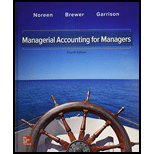
1a.
To prepare: A contribution format income statement showing both dollar and percentage for each product and for the company as whole.
Introduction:
Break-even point:
Break-even point is the point at which there is no
1b.
To compute: The company’s break-even point in dollar sales and to calculate its margin of safety in dollars and percentage.
Introduction:
Break-even point:
Break-even point is the point at which there is no profit or no loss because at this point the total cost is equal to the total sales revenue generated by the company. The contribution earned by the company is sufficient to cover all its costs at the break-even point and if the contribution is lesser then it is loss and if it is higher, then it is profit.
2a.
To prepare:A revised contribution format income statement that includes Samoan delight assuming that the sales of the other two products does not change.
Introduction:
Break-even point:
Break-even point is the point at which there is no profit or no loss because at this point the total cost is equal to the total sales revenue generated by the company. The contribution earned by the company is sufficient to cover all its costs at the break-even point and if the contribution is lesser then it is loss and if it is higher, then it is profit.
2b.
To compute: The company’s revised break-even point in dollar sales and to calculate its revised margin of safety in dollars and percentage.
Introduction:
Break-even point:
Break-even point is the point at which there is no profit or no loss because at this point the total cost is equal to the total sales revenue generated by the company. The contribution earned by the company is sufficient to cover all its costs at the break-even point and if the contribution is lesser then it is loss and if it is higher, then it is profit.
3.
To explain: the reason to the president for a higher break-even point even though the contribution margin has increased with the addition of new product.
Introduction:
Break-even point:
Break-even point is the point at which there is no profit or no loss because at this point the total cost is equal to the total sales revenue generated by the company. The contribution earned by the company is sufficient to cover all its costs at the break-even point and if the contribution is lesser then it is loss and if it is higher, then it is profit.
Trending nowThis is a popular solution!

Chapter 3 Solutions
GEN COMBO MANAGERIAL ACCOUNTING FOR MANAGERS; CONNECT 1S ACCESS CARD
- I need help with this financial accounting question using standard accounting techniques.arrow_forwardI need help with this general accounting question using standard accounting techniques.arrow_forwardI am trying to find the accurate solution to this financial accounting problem with the correct explanation.arrow_forward
- Please help me solve this financial accounting question using the right financial principles.arrow_forwardPlease explain the solution to this financial accounting problem with accurate explanations.arrow_forwardPlease explain the correct approach for solving this financial accounting question.arrow_forward
- Please provide the answer to this financial accounting question with proper steps.arrow_forwardI am searching for the correct answer to this financial accounting problem with proper accounting rules.arrow_forwardI need help finding the accurate solution to this financial accounting problem with valid methods.arrow_forward
- I am looking for help with this general accounting question using proper accounting standards.arrow_forwardCan you explain this financial accounting question using accurate calculation methods?arrow_forwardPlease explain the correct approach for solving this financial accounting question.arrow_forward

 AccountingAccountingISBN:9781337272094Author:WARREN, Carl S., Reeve, James M., Duchac, Jonathan E.Publisher:Cengage Learning,
AccountingAccountingISBN:9781337272094Author:WARREN, Carl S., Reeve, James M., Duchac, Jonathan E.Publisher:Cengage Learning, Accounting Information SystemsAccountingISBN:9781337619202Author:Hall, James A.Publisher:Cengage Learning,
Accounting Information SystemsAccountingISBN:9781337619202Author:Hall, James A.Publisher:Cengage Learning, Horngren's Cost Accounting: A Managerial Emphasis...AccountingISBN:9780134475585Author:Srikant M. Datar, Madhav V. RajanPublisher:PEARSON
Horngren's Cost Accounting: A Managerial Emphasis...AccountingISBN:9780134475585Author:Srikant M. Datar, Madhav V. RajanPublisher:PEARSON Intermediate AccountingAccountingISBN:9781259722660Author:J. David Spiceland, Mark W. Nelson, Wayne M ThomasPublisher:McGraw-Hill Education
Intermediate AccountingAccountingISBN:9781259722660Author:J. David Spiceland, Mark W. Nelson, Wayne M ThomasPublisher:McGraw-Hill Education Financial and Managerial AccountingAccountingISBN:9781259726705Author:John J Wild, Ken W. Shaw, Barbara Chiappetta Fundamental Accounting PrinciplesPublisher:McGraw-Hill Education
Financial and Managerial AccountingAccountingISBN:9781259726705Author:John J Wild, Ken W. Shaw, Barbara Chiappetta Fundamental Accounting PrinciplesPublisher:McGraw-Hill Education





